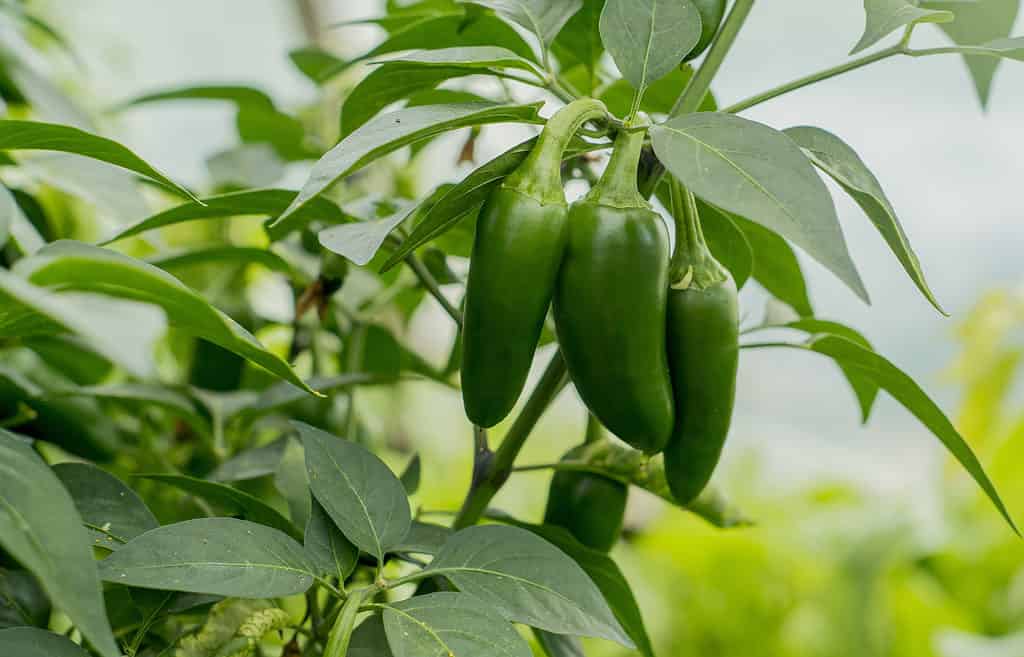If there is a pepper in the world that almost everyone has heard of, it’s the jalapeño. Perfectly suited for almost any dish, the jalapeño is a balance of sweet, spicy, and tasty that everyone loves. Today, we are going to take a look at these famous peppers in order to find out just how spicy they are. Plus, we are going to learn about the history of the Scoville scale and the hottest peppers ever to exist. Let’s get started!

Jalapeño peppers provide a balance of sweetness, spice, and flavor that has made them one of the most popular peppers around.
©Gatis Grinbergs/Shutterstock.com
How Hot Are Jalapeño Peppers on the Scoville Scale?
Jalapeño peppers are a popular type of chili pepper that originated in Mexico. They are named after the city of Xalapa, Veracruz, where they were first grown. Jalapeños are typically 2-3 inches long and have a dark green color when they are ripe. They have a slightly curved shape and a smooth, glossy skin.
In terms of heat level, jalapeño peppers fall on the lower end of the Scoville scale, with a rating of 2,500-8,000 Scoville heat units. This makes them milder than some other types of chili peppers, such as habaneros or ghost peppers. They are considered medium-heat peppers, which makes them a popular choice for adding a bit of spice to dishes without overwhelming the other flavors.

In terms of heat level, jalapeño peppers fall on the lower end of the Scoville scale, with a rating of 2,500-8,000 Scoville heat units.
©Svetlana Foote/Shutterstock.com
What is the Scoville Scale?
The Scoville scale is a measurement of the heat level in peppers and other spicy foods. It was developed by Wilbur Scoville in 1912 to rank certain peppers on their heat in a somewhat consistent manner. The scale measures the concentration of capsaicin, the chemical compound that gives peppers their heat and burns our mouths. The scale ranges from 0 (no heat) to over 2,000,000 (extremely hot) Scoville heat units. The original method for testing pepper heat, called the Scoville Organoleptic Test, would involve a panel of testers, tasting dilutions of pepper extract mixed with sugar water until the “heat” is no longer perceptible, giving it a score.
The method was not very accurate and had a lot of human error (since heat is a bit subjective), so now it’s replaced by the high-performance liquid chromatography (HPLC) method, which is considered a more accurate and scientific method. The HPLC method can measure the exact amount of capsaicinoids (capsaicin oil molecules) present in a pepper, which gives a more accurate measure of its heat level. This method is more reliable and consistent than the original test, and it allows for a more precise measurement of a pepper’s heat. This allows for a better understanding of the heat level of different peppers, and it helps people choose the right pepper for their taste and desired level of spice!

The Scoville scale is a measurement of the heat level in peppers and other spicy foods.
©iStock.com/Julie Deshaies
How Are Jalapeños Used in Cooking?
Jalapeños aren’t some of the most popular peppers in the world for nothing! The taste of jalapeño is usually described as sweet, grassy, and spicy, but methods have been created to give them a huge array of tastes. Chipotle peppers, for example, are just jalapeños that have been smoke-dried to give it a smokier and more developed flavor.
Jalapeños are often used in salsas, guacamoles, chili, soups, and as a topping for nachos. They can also be pickled or canned, and are often used as an ingredient in hot sauce. They can be eaten raw, grilled, smoked, or fried, and they’re great for adding a bit of heat and flavor to sandwiches and burgers. They are also a popular pizza topping, and they can be used in dips, dressings, and marinades. Jalapeño peppers are a great ingredient for adding a bit of heat and flavor to a wide variety of dishes.

Jalapeños are often used in salsas, guacamoles, chili, soups, and as a topping for nachos.
©iStock.com/Marcos Elihu Castillo Ramirez
The Hottest Peppers in the World (on the Scoville Scale)
To get an idea of how hot peppers are, here is a list of some of the most famous peppers out there and how they relate in spice to the humble jalapeño:
- Ghost Pepper (Bhut Jolokia) – over 1,000,000 Scoville heat units
- Carolina Reaper – over 2,200,000 Scoville heat units
- Trinidad Scorpion – over 1,400,000 Scoville heat units
- 7 Pot Douglah – over 1,200,000 Scoville heat units
- 7 Pot Primo – over 1,200,000 Scoville heat units
- Naga Viper – over 1,349,000 Scoville heat units
- Moruga Scorpion – over 2,009,231 Scoville heat units
- Habanero – 100,000-350,000 Scoville heat units
- Scotch Bonnet – 100,000-350,000 Scoville heat units
- Jalapeño – 2,500-8,000 Scoville heat units
It’s important to note, however, that spice isn’t always the same. Certain chemicals have different reactions in the mouth and can create different sensations. For example, one pepper may have a “stinging” spice, whereas another has a “slow build” sensation, even if they are identical on the Scoville scale. The amazing diversity of spice, flavor, and sensation makes peppers some of the most diverse foods in the world and a wonderful addition to various cuisines and sauces.
The jalapeño is a great starting point for anyone to dip their toes in the water of spice!
Up Next
- Scoville Scale: How Hot Are Takis
- Horseradish vs. Ginger: Are They the Same Plant?
- Can Dogs Eat Spicy Food Safely? What Happens If They Do?
The photo featured at the top of this post is © Chris Bradshaw/Shutterstock.com
Thank you for reading! Have some feedback for us? Contact the AZ Animals editorial team.






